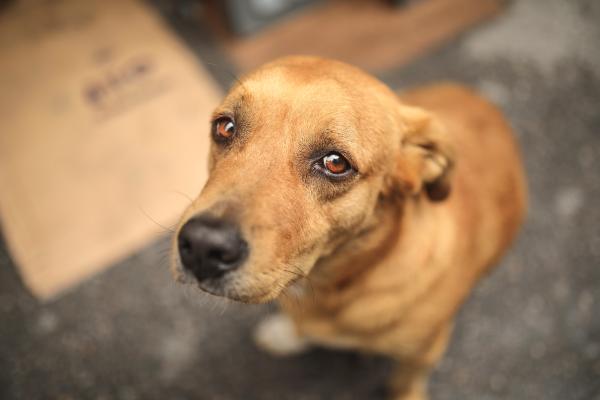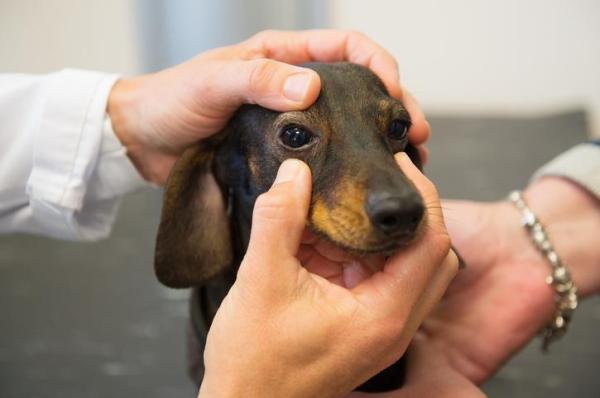Why Is My Dog Wobbly When Walking?



See files for Dogs
A dog is wobbly when they walk either because they have a mechanical issue with their legs or because there is a problem with their central nervous system. Obvious causes of wobbling in dogs include trauma which makes their limbs function improperly. However, there are also neurological conditions and other nervous system problems which means they cannot walk without wobbling. Some of these are so significant, the dog may lose the ability to walk at all if the problem is not addressed.
At AnimalWised, we ask why is my dog wobbly when walking? We discover the causes of a dog losing their balance, as well as what treatment options are available to help them recover their gait.
- Reasons why my dog is wobbly
- Trauma
- Spinal problems
- Poisoning
- Joint problems
- Vestibular disease
- Organ failure
- Dehydration
- Symptom of an underlying disease
- Neurological disorders
- What to do when my dog is wobbly when walking
Reasons why my dog is wobbly
As explained in the introduction, a dog's wobbly walk can be caused by the limbs themselves not being able to work properly or because the controls of their limbs are not functioning. However, there are many ways both circumstances can occur. Some are degenerative and will progress over a long period of time. Others will occur all of a sudden and can be shocking to the guardian.
Some of the most common causes of a dog losing their balance while walking include the following:
- Trauma
- Spinal problems
- Poisoning
- Joint problems
- Vestibular disease
- Organ failure
- Dehydration
- Symptom of underlying disease
- Neurological disorders
We look into more detail the causes, treatment and related symptoms of these reasons why a dog is wobbly.
Trauma
When a dog is hit with a strong force on their limbs, it can change their gait significantly. Various types of trauma can lead to a wobbly dog. One of the most common is a vehicular collision, especially in dogs that live in urban areas. If a dog escapes the house or is given outdoor access, they can run into the road and be hit by a car.
Trauma can also come from fighting with other animals. Fighting is more common in dogs which have not been neutered, especially males around a female in heat. The fighting can be sufficiently aggressive to cause serious harm to the dog's limbs.
Trauma can also come from falls and other accidents. They can cause breaks in the bones of their legs, leading them to change their gait and wobble when they walk. However, traumatic events can also affect other parts of the body and lead to wobbling when walking. These include injuries to the spine and brain.

Spinal problems
The vertebrae contain the spinal cord, itself a set of nervous tissue which is vital for carrying out bodily functions. This includes walking. Traumatic injury can cause damage to the spinal cord, but other spinal problems can also cause a dog to be wobbly when walking.
One common issue is a herniated disc. This problem can be a result of trauma, but it can also herniate for other reasons. A herniated disc occurs when protective tissue from the dog's spinal cord is injured, often protruding from the disc itself. It can also be caused by the dog straining too much or being made to adopt awkward postures.
Spinal problems in dogs may be as a result of diseases or other conditions which can damage the nervous tissue of the spinal cord. This can be a result of neoplasms such as tumors, both benign and malignant. The tumors can put pressure on the spine and change their gait. Infections to the spinal cord can also be very serious and result in symptoms such as a change in gait.
Another spinal disease which changes how dogs walk is spondylomyelopathy, also known as wobbler syndrome in dogs. This usually affects large and giant breeds of dog such as the Doberman or Great Dane[1]. It is caused by a hernia or malformation, although there is still much unknown about the condition. Treatment may require surgery, depending on the advice of the veterinarian.
Learn more about spinal problems in dogs with our article on why a dog has lower back pain.
Poisoning
When a dog ingests something toxic, it can have serious repercussions to their overall organism. These repercussions are usually generalized and affect their whole body, including making them wobbly when walking. How much they are affected will depend on the type of toxin ingested, the amount of toxin ingested, the health status of the dog and other factors.
Toxins are ever present in the dog's environment. These can be in the form of household items which can kill your dog such as cleaning products or medications, but they can also be from seemingly innocuous items. For example, chocolate is something which can intoxicate your dog when eaten in sufficient quantities, as can various plants common in the home.
Treatment of poisoning in dogs will begin with stabilizing their system. This can include gastric lavage and fluid therapy, but it will depend on the type of toxin, as well as how long has elapsed since the poisoning. If poisoning has caused the dog to wobble, it means it has progressed significantly and that the intoxication is strong.
Joint problems
Joint problems can affect a dog at any stage of their life, but they are particularly common in older dogs. This is because years of wear and tear can take their toll on the tissue surrounding the joints.
Certain breeds are more prone to joint disorders than others. These include German Shepherds, Great Danes and types of Dachshunds. This is due to the genetic traits which are passed down through generations. It can lead to joint malformation which will worsen over time.
If your dog has stiff joints, it can result in them wobbling when they walk. Treatment of joint problems is not usually curative. Instead, it is based on stopping the degeneration of the joints. This will be based on various factors, including changes to the diet and exercise regimens, although it is possible surgical intervention may be carried out.
Learn more about joint problems in dogs with our article on types of canine ataxia.
Vestibular disease
Dogs maintain their balance not only with their limbs and nervous system, but also their vestibular system. This is the sensory system which affects balance and spatial awareness. It is connected to the auditory system. Although the component parts are small and delicate, they can significantly affect the rest of the dog's organism.
When something is wrong with the vestibular system's component parts, it results in vestibular syndrome in dogs. This is a set of various symptoms which includes a wobbly gait, as well as difficulty eating, excessive drooling, dizziness and various other clinical signs. One of the most common causes is otitis in dogs, an inflammation of the ear canal. However, it is also often idiopathic, meaning there is no known origin.
Treatment of vestibular syndrome will depend on the cause. For otitis, it may be sufficient to use antibiotics to use antibiotics to cure the inflammation. However, treatment of idiopathic vestibular system is much more difficult. Fortunately, it often resolves itself on its own.
Organ failure
The cause of the organ failure can be various. It can be as a result of the previously mentioned acute intoxication, but it can also happen when toxins accumulate over a long time. Whether due to poor diet, a genetic predisposition or other factors, liver, kidney and other organ failure can result in the dog being wobbly when walking.
Diagnosis from a trusted veterinarian must be carried out to determine the extent of the organ failure. If it is in early stages, dietary, exercise and lifestyle changes can provide sustained quality of life. If the organ failure is sufficiently progressed to the point they are wobbling, it may mean the organ failure is too extensive. In these cases, the dog may need to be euthanized.

Dehydration
When a dog does not have sufficient water, they will become dehydrated. This can be due to a lack of access to fresh water or to a condition which results in dehydration. Times of high ambient temperature are more likely to cause dehydration, as well as conditions such as hyperthermia in dogs. Some diseases cause the dog to require more water to continue bodily functions. When they do not have this hydration, their system can start to fail and result in a wobbly walk.
Treatment of dehydration requires giving the dog more fluids. It can be enough to encourage the dog to drink more water, but acute dehydration may require veterinary treatment such as intravenous fluid therapy. Prevention is best, so we will need to ensure we provide enough water, as well as help the dog keep cool during the summer.
Symptom of an underlying disease
A dog losing their balance can be the result of various underlying diseases which affect their entire organism. These diseases can be chronic or acute, depending on whether the loss of balance is sudden or develops over time. Some of the diseases which can cause a dog to wobble when they walk include:
- Stroke
- Cancer
- Encephalitis (brain inflammation)
- Canine distemper
- Parvovirus
These are only some of the diseases which can result in a dog having a wobbly walk, but you can see they can be quite serious. Treatment will depend on the underlying cause.
Neurological disorders
Similar to joint problems, neurological disorders can affect a dog at any stage of life, but they are particularly common in older dogs. As with joints, the dog's brain can be affected by various conditions over time and lose functioning.
This can result in something known as canine cognitive dysfunction (CCD). This is a condition which is similar to Alzheimer's disease in humans. As with Alzheimer's, it is not well understood by clinicians. It will be observed when we see various behavioral changes in the dog. They can develop disorientation, poor sleep, barking at nothing or even becoming aggressive. Loss of balance is also a common symptom.
Since the causes of neurological disorders in dogs are not always well known, the treatment options are limited. Monitoring of the progression is essential and most treatment is based on symptom management. Once sufficiently progressed, it is possible the dog will become a danger to themselves and others.

What to do when my dog is wobbly when walking
As we can see, there are various causes of loss of balance in dogs. Regardless if we see the dog's walk changes suddenly, we need to take the dog to a veterinarian for assessment. Some cases are emergency situations and will require immediate intervention. Others may be part of a progressive disorder and early intervention can prevent the symptoms worsening.
Preventive measures in the form of vaccination and deworming schedules can help the dog avoid some of the health issues which can result in balance loss. Ensuring their basic needs are met and being observant of any physical or behavioral changes are also vital.

This article is purely informative. AnimalWised does not have the authority to prescribe any veterinary treatment or create a diagnosis. We invite you to take your pet to the veterinarian if they are suffering from any condition or pain.
If you want to read similar articles to Why Is My Dog Wobbly When Walking?, we recommend you visit our Other health problems category.
1. da Costa R. C. (2010). Cervical spondylomyelopathy (wobbler syndrome) in dogs. The Veterinary clinics of North America. Small animal practice, 40(5), 881–913.
https://doi.org/10.1016/j.cvsm.2010.06.003








